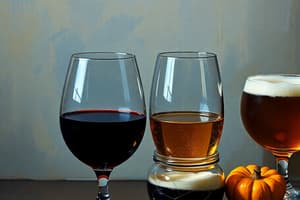Podcast
Questions and Answers
What type of yeast is used in ales that contributes to fruity flavors?
What type of yeast is used in ales that contributes to fruity flavors?
- Lager yeasts
- Top-fermenting yeasts (correct)
- Wild yeasts
- Bottom-fermenting yeasts
Lagers produce a crisper tasting beer compared to ales.
Lagers produce a crisper tasting beer compared to ales.
True (A)
What is the alcohol content range of fortified wine?
What is the alcohol content range of fortified wine?
19-22%
Porters are a type of _____ known for their dark color.
Porters are a type of _____ known for their dark color.
Match the type of wine with its characteristic:
Match the type of wine with its characteristic:
During which step is the must optimized for TSS and pH?
During which step is the must optimized for TSS and pH?
Cold sterilization involves warming the fermented must.
Cold sterilization involves warming the fermented must.
What compounds can be added during the blending and fining step to improve wine quality?
What compounds can be added during the blending and fining step to improve wine quality?
Flashcards
Top-fermenting yeast
Top-fermenting yeast
Yeasts that produce fruity flavors in ales (like apple, pear, etc.).
Lager yeast
Lager yeast
Yeasts producing crisper, cleaner-tasting beers by fermenting at lower temperatures.
Wine pigmentation
Wine pigmentation
Red wine is pigmented; white wine is not.
Wine fermentation
Wine fermentation
Signup and view all the flashcards
Wine alcohol content
Wine alcohol content
Signup and view all the flashcards
Wine harvesting
Wine harvesting
Signup and view all the flashcards
Primary fermentation
Primary fermentation
Signup and view all the flashcards
Secondary fermentation
Secondary fermentation
Signup and view all the flashcards
Study Notes
Beer Types
- Top-fermenting yeasts create esters and fruity aromas (apple, pear, etc.) in ales.
- Lager yeasts ferment at lower temps, resulting in a crisp taste and inhibiting ester production.
- Imperial lagers have the highest alcohol content.
Porter
- Porters are a type of ale with a dark color and roasted malt aroma.
- Flavor can be fruity or dry, depending on the malt used.
Wine Production
-
Step 1: Harvesting: Fruits/berries are harvested, skins removed for white wine, and coloring is extracted with steaming.
-
Step 3: Optimization: Must (fruit juice/must) optimized for TSS (total soluble solids) and pH. Potassium metabisulphite (KNS) may be added for antimicrobial, antioxidant, and antifungal action.
-
Step 4: Primary Fermentation: Must is inoculated with 2-10% of yeast for 3-5 days (red wine) or 7-14 days (white wine). Optimal temperatures are needed.
-
Step 6/7: Heat and Cold Sterilization/Secondary Fermentation: Fermentation continues with heat/cold sterilization to develop aroma compounds. The aroma may be volatile or non-volatile produced by chemical reactions between acids, sugars, alcohols, and phenolic compounds.
-
Step 9: Blending and Fining: Spices, aromatic extracts, fruit juices, etc are added. Tannins and particles are removed for clearer wine.
Studying That Suits You
Use AI to generate personalized quizzes and flashcards to suit your learning preferences.




